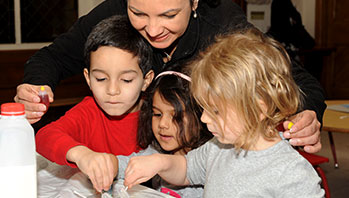- alfalfa or clover sprout seeds
- aluminum pie pan
- books or other items to lean jar against
- chart paper
- cheesecloth
- glass jar
- marker
- rubber band
- drain
- plant
- rot
- seed
- soil
- sprout
MA Standards:
English Language Arts/Language/L.PK.MA.6 Use words and phrases acquired through conversations, listening to books read aloud, activities, and play.
Head Start Outcomes:
Science Knowledge/Scientific Skills and Method Uses senses and tools, including technology, to gather information, investigate materials, and observe processes and relationships.
Science Knowledge/Scientific Skills and Method Participates in simple investigations to form hypotheses, gather observations, draw conclusions, and form generalizations.
PreK Learning Guidelines:
English Language Arts/Language 2 Participate actively in discussions, listen to the ideas of others, and ask and answer relevant questions.
Small Group: Growing Sprouts #1

© Commonwealth of Massachusetts, Department of Early Education and Care (Jennifer Waddell photographer). All rights reserved.
STEM Key Concepts: Some plants start from seeds; Plants grow in many places; Many foods that animals, including humans, eat come from plants; We eat certain leaves, roots, fruits, and seeds; Understand that a seed holds what a plant needs to make more of itself
ELA Focus Skills: Listening and Speaking, Vocabulary
Educator Prep: The day before doing this activity, sterilize the glass jar by placing it in boiling water for 5 minutes. Place 1–2 tablespoons of sprout seeds in the jar. Cover the jar with cheesecloth and hold it in place with a rubber band. Leaving the cheesecloth on top, fill the jar with water and soak the seeds overnight. The next day, turn the jar over to drain the water thoroughly. You can find sprout seeds at health food stores or online. Save some sprout seeds for discussion.
Display the sprouts and talk about how animals eat different plants. Ask, Do you remember what worms eat? (grass, plant parts) Can you name any plants that you eat? If necessary, prompt children with questions such as, Have you ever eaten a salad? Do you know what was in it?
Tell children that over the next few days they are going to grow sprouts that can be eaten in a salad. Today, work with children to prepare the seeds for planting. Over the next four days, work with children in small group activities to take care of the plants.
Show children the seeds that you have soaked overnight and talk about them. Ask if any children have eaten sprouts before. If so, have the children describe the sprouts using sensory words: how they tasted, felt, and smelled. Then ask,
- What do you think we need to do to help the seeds to become sprouts?
- What other seeds have we observed that were not planted in soil? Do you think these seeds will sprout the same way? Why do you think that?
- Encourage children to think about what they’ve learned about plants’ needs. Record their ideas on chart paper.
Guide children as they rinse the seeds, then follow these steps:
- Make sure the cheesecloth is secure on top
- Fill the jar with water
- Then tip the jar and drain all of the water out.
Explain that it’s important to drain the seeds thoroughly after each rinse or the seeds will rot, or go bad. After rinsing the seeds, leave the jar upside down and tilted in an aluminum pie pan against books or other items.
Take It Further: You may want to leave some of the seeds in water so children can watch what happens to them if the water is not drained out after rinsing. Have children view and smell the rotten seeds and ask them to describe what they see/smell.
